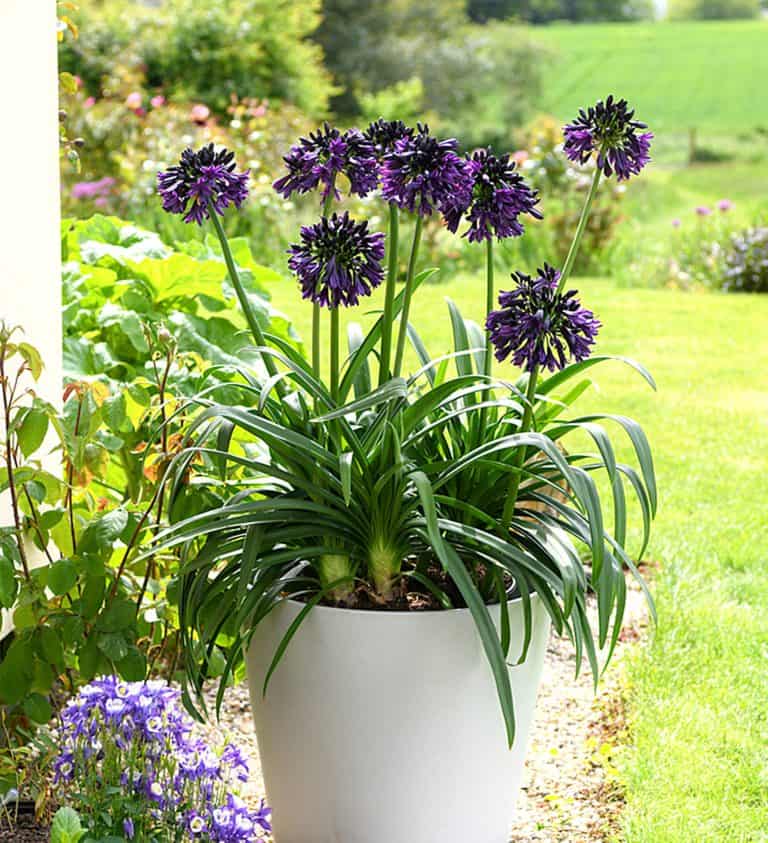Common Agapanthus Problems and Just How to Address Them
Common Agapanthus Problems and Just How to Address Them
Blog Article
Grasping the Art of Agapanthus Care: Important Steps for Healthy Growth and Lively Flowers
In the realm of cultivation, the farming of agapanthus stands as a gratifying venture for those who seek to nurture these elegant flowering plants. With their striking blossoms and stylish vegetation, agapanthus has actually captured the focus of gardeners worldwide. However, accomplishing optimal development and lively blossoms calls for a nuanced approach that includes different essential steps. From selecting the right range to mastering trimming strategies, the journey in the direction of growing prospering agapanthus plants is diverse and holds the essential to opening the complete possibility of these botanical gems.

Picking the Right Agapanthus Range

When choosing the best Agapanthus variety for your garden, take into consideration factors such as climate suitability, blossom color, and growth practice. Additionally, consider the environment in your area to make sure the Agapanthus variety you choose can grow in your particular conditions. Recognizing the growth behavior of different Agapanthus ranges is essential for appropriate placement within your yard.
Perfect Planting Problems
Considering the optimum environmental needs is essential for successful Agapanthus cultivation. Agapanthus thrives in well-draining soil with a somewhat acidic to neutral pH degree. When growing, choose a location that receives full sunshine to partial shade. In hotter climates, providing some mid-day color can prevent scorching of the fallen leaves. Agapanthus plants are delicate to chilly temperature levels and need to be safeguarded from frost throughout winter months.
To make certain healthy development and dynamic blossoms, plant Agapanthus bulbs at a deepness of regarding 2-4 inches and area them 8-12 inches apart. Including raw material, such as compost, to the dirt can improve drainage and fertility, advertising robust root growth. Mulching around the base of the plants helps retain wetness and reduces weed growth. Normal watering is essential, specifically throughout the expanding period, to keep the soil continually damp yet not soaked.
Watering and Feeding Tips
Keeping correct moisture levels and giving essential nutrients are vital elements in the treatment routine for Agapanthus plants. When it comes to sprinkling Agapanthus, it is critical to strike an equilibrium. These plants favor regularly wet soil however are prone to root rot if overwatered.
Feeding Agapanthus is crucial for advertising healthy and balanced growth and prolific flowers. Use a balanced plant food, such as a 10-10-10 formula, in the very early springtime as new development emerges. Repeat this application every 6-8 weeks throughout the expanding season. Prevent extreme fertilizing, as it can result in lush foliage at the expenditure of flowers. Constantly adhere to the manufacturer's instructions for appropriate her comment is here dilution and application methods. By complying with these watering and fertilizing suggestions, you can ensure your Agapanthus plants flourish and generate lively, lasting flowers.
Trimming Techniques for Agapanthus
Trimming Agapanthus plants at the appropriate times and with appropriate techniques is essential for maintaining their wellness and advertising optimal growth and blooming. The perfect time to trim Agapanthus is in late wintertime or very early springtime prior to new growth arises.
Deadheading invested blossoms can additionally redirect the plant's energy right into creating more click over here now blooms instead than setting seeds. If you want to gather seeds for propagation, leave some flowers to dry and mature on the plant.
Bear in mind to make use of clean, sharp devices to make accurate cuts and reduce the risk of introducing conditions. Agapanthus. Regular pruning will assist maintain your Agapanthus looking cool and healthy and balanced while making certain an abundant screen of attractive blooms
Handling Common Parasites and Diseases
After guaranteeing proper trimming strategies for Agapanthus, it is essential to resolve typical pests and illness that can influence the wellness and vigor of these plants. One common parasite that influences Agapanthus is the Agapanthus gall midget.
An additional typical problem is fungal fallen leave spot, which provides as dark sores on the fallen leaves. To protect against fungal official site conditions, guarantee excellent air blood circulation around the plants, prevent overhead watering, and remove any type of infected fallen leaves immediately. Furthermore, Agapanthus plants can endure from origin rot if they are planted in poorly draining pipes dirt. To stop this, plant Agapanthus in well-draining dirt and prevent overwatering. By being vigilant and taking prompt action versus conditions and parasites, you can assist your Agapanthus plants grow and create dynamic blossoms.

Verdict
In conclusion, understanding the art of agapanthus care includes choosing the appropriate selection, giving excellent growing conditions, correct watering and fertilizing, ideal trimming methods, and dealing with usual bugs and conditions. By following these vital actions, you can ensure healthy growth and dynamic flowers for your agapanthus plants. Remember to regularly keep an eye on and maintain your plants to advertise their total wellness and longevity.
To guarantee healthy and balanced development and vibrant flowers, plant Agapanthus bulbs at a deepness of concerning 2-4 inches and area them 8-12 inches apart. By complying with these watering and fertilizing suggestions, you can guarantee your Agapanthus plants prosper and produce vivid, durable flowers.
One common bug that influences Agapanthus is the Agapanthus gall midget. Additionally, Agapanthus plants can suffer from root rot if they are planted in improperly draining pipes soil. By complying with these vital actions, you can make sure healthy development and vivid blooms for your agapanthus plants.
Report this page